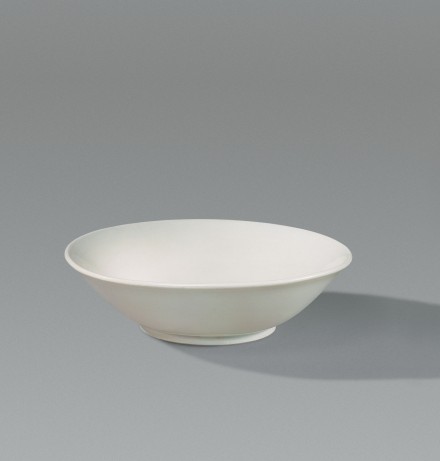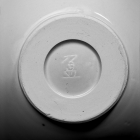J.J. Lally & Co., Oriental Art / New York City, New York
MenuPast Exhibition
Early Chinese Ceramics: An American Private Collection
March 28 - April 16, 2005

18.
A XINGYAO WHITE PORCELAIN SHALLOW BOWL
Tang Dynasty, A.D. 9th/early 10th century
of well potted circular form, with steeply rounded flaring sides turned out slightly at the lip, standing on a thick ring foot of bi-disc shape with chamfered edge, the underside of the foot unglazed revealing the very smooth white porcelain body, the clear glaze covering the interior and exterior showing a very pale grayish-silvery tone, the recessed center of the base also glazed and engraved before firing with a single character ying.
Diameter 6 1⁄8 inches (15.5 cm)
A fragmentary white porcelain base, of very similar form and engraved with the character ying incised before firing in a similar quickly written regular script style, was excavated at the Tang dynasty Daming Palace site in Xi’an, Shaanxi and is illustrated by Feng Xianming in Essays on Chinese Old Ceramics, Hong Kong, 1987, p. 191, pl. 10, described as Xingyao.
The same incised ying character appears on the base of a Xingyao white porcelain circular box and cover in the Shanghai Museum, included in the travelling exhibition in Japan which opened at the Tokyo National Museum in July 1984, and illustrated in the catalogue entitled Zhongguo Lidai Taoci Zhan (Exhibition of Chinese Ceramics Through the Ages), Tokyo, 1984, no. 32, p. 60, and a Xingyao ovoid jar with the character ying incised on the base in the Carl Kempe Collection is illustrated by Gyllensvärd, Chinese Ceramics in the Carl Kempe Collection, Stockholm, 1964, p. 103, no. 298.
唐 邢窯白瓷碗 徑 15.5 厘米
Additional Images (Touch to enlarge)
18.
A XINGYAO WHITE PORCELAIN SHALLOW BOWL
Tang Dynasty, A.D. 9th/early 10th century
Diameter 6 1⁄8 inches (15.5 cm)
